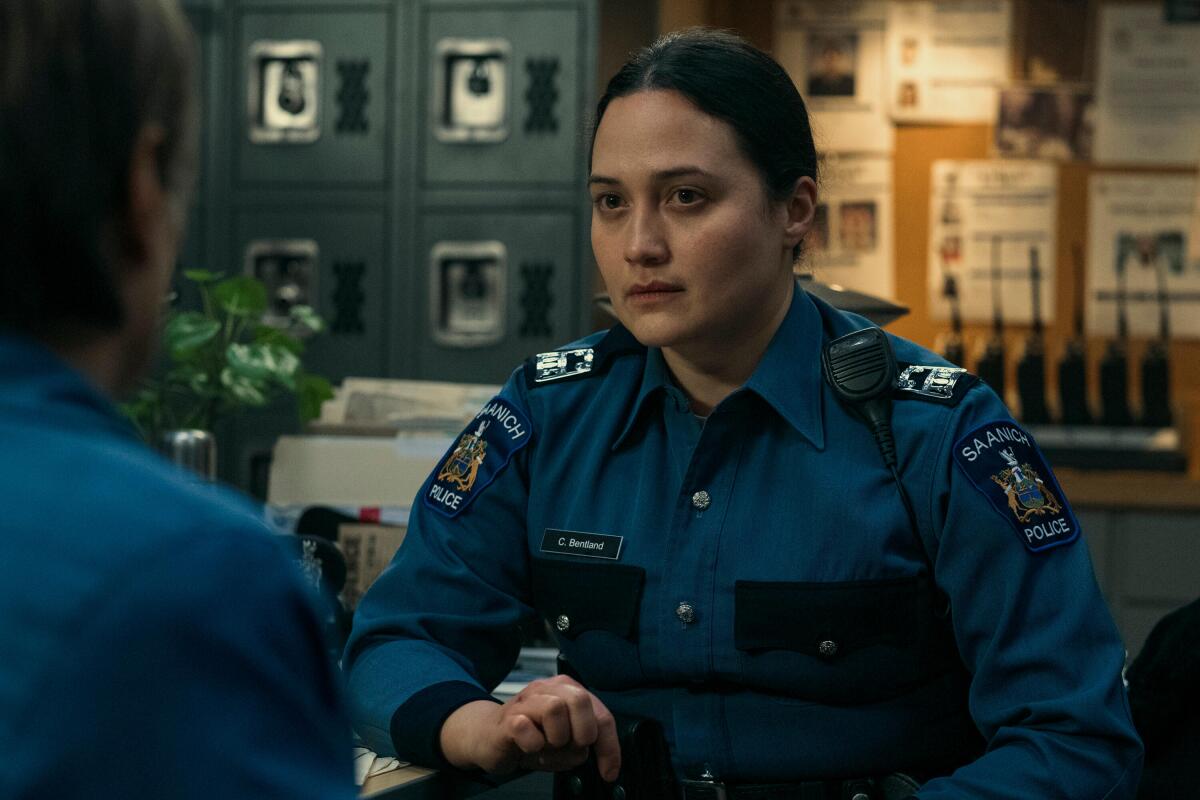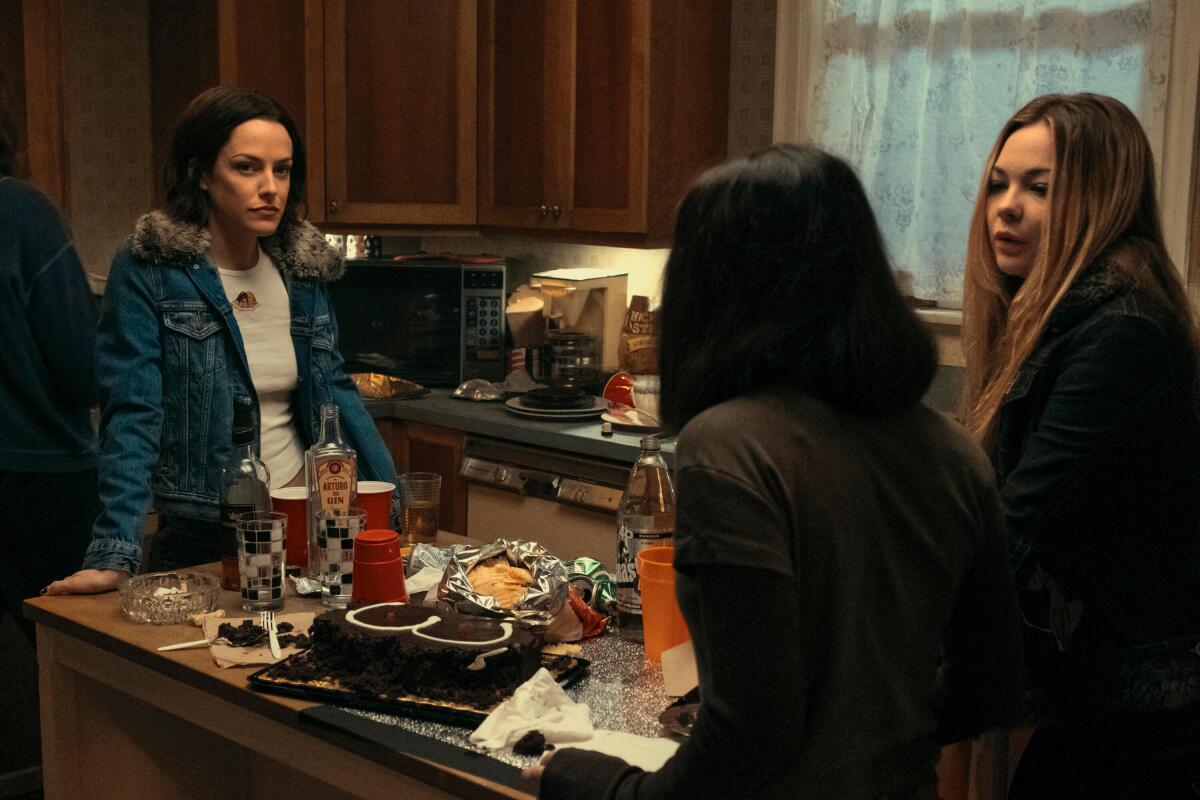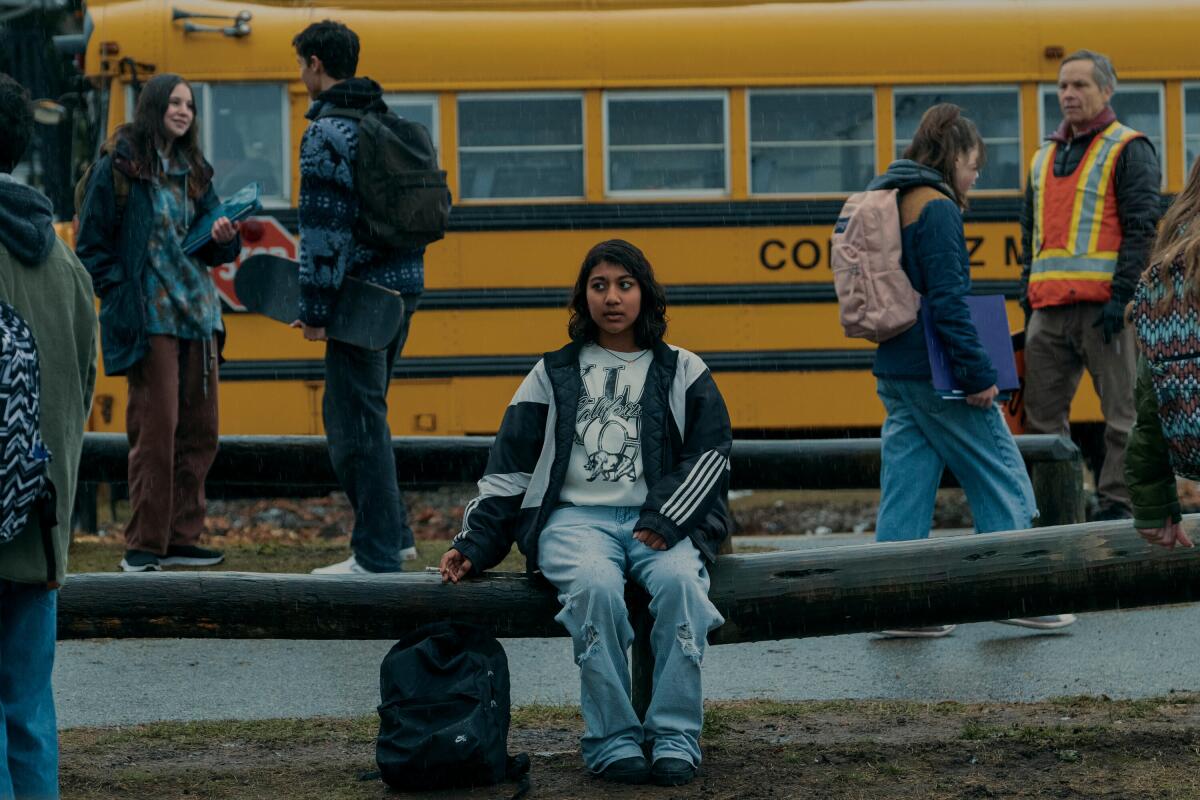Lily Gladstone and Riley Keough shine in Hulu’s dark true-crime drama ‘Under the Bridge’

- Share via
“Based on a true story” — why do we care? Does it matter whether the events of a dramatic work “really happened,” or sort of happened, more or less in the way we’re being told? Is it a come-on to prurient interests, when the subject is dark or sensational? Is it to appear educational? Is it to advertise that things that seem too incredible to be true really are true, to make what’s shocking even more shocking, or to prop up a story that can’t stand on its own?
If I had a definite answer for you, there wouldn’t have been so many question marks in the preceding paragraph. All of the above, maybe.
“Dragnet” changed the names to protect the innocent, but nowadays it’s the fashion to keep the names, while the facts, found wanting on their own, might get a fictional assist. In “Under the Bridge,” a limited series based on Rebecca Godfrey’s well-received 2005 book about the 1997 murder of 14-year-old Reena Virk in green and watery Victoria, British Columbia, some of the names are the same; others have been changed, as they were on the page, in accordance with Canadian law protecting the identities of young people accused or convicted of a crime; and yet other names have been made up, along with the characters who wear them.

Godfrey’s book falls under the rubric of true crime, if of a particularly literary sort; she was interviewed about it in the Paris Review, and Mary Gaitskill wrote the introduction to its 2019 rerelease. Still, unless you feel it’s imperative that this story of a teenager fatally set upon other teenagers has a basis in reality, it might be best to regard the TV adaptation as fiction clear through — “Lord of the Flies” wasn’t based on anything, after all — something like the fifth season of “True Detective,” perhaps, especially given Riley Keough and Lily Gladstone are in starring roles.
Godfrey isn’t a presence in “Under the Bridge,” but, played by Keough, she’s become a major character in the series — a subject nearly, an active participant, a person with her own measure of trauma to address. Developed by Quinn Shephard, whose 2017 film “Blame” is also a story of toxic teenhood, the adaptation is true to the facts of the case itself, as reported by Godfrey and others. Much of what surrounds it, however, has been invented or altered for your entertainment — especially as it concerns the investigation, in which the author, returning home to Victoria for the first time in 10 years, becomes an unofficial detective, if one with mixed motives.
She has come, coincidentally, to write a book, on “the misunderstood girls of Victoria,” of which she was once one, when these characters fall into her lap.
Vritika Gupta plays Reena, an outsider desperate to belong, a child awkwardly attempting to imitate an adult, chafing at the strictures of her conservative Jehovah’s Witness parents (Archie Panjabi as Suman and Ezra Faroque Khan as Manjit). To her happy surprise, she finds herself recruited into a tribe of more sophisticated girls — which is to say, they smoke and drink and take drugs. Their leader, Josephine (Chloe Guidry), wears John Gotti’s picture in a locket and controls a legion of “minions” who shoplift on her behalf. (They call themselves the Crip Mafia Cartel, while the police refer to them as “Bic” girls, as in the lighter, “’cause we’re disposable.”) Her lieutenants are Kelly (Izzy G.), Jo’s best friend, and Dusty (Aiyana Goodfellow), who is relatively nice. After a honeymoon period, a series of unfortunate events will lead to the even more unfortunate event that has brought us all here.
Rebecca’s return to town has its own measure of friction. (She doesn’t get along with her mother, either.) Significantly, it brings her back into contact with local police officer Cam (Gladstone), with whom Rebecca and her late brother once were close. (Just how close is hinted at, but never explored.) When Reena’s father and her uncle Raj (Anoop Desai) come to file a missing persons report, Cam is ready at first — along with the rest of the department, including her adoptive father (Matt Craven), the police chief — to write her off as a runaway. But she’ll change her tune and wind up spearheading the investigation, while she wars with Rebecca over her intentions and intrusions and questionable journalistic ethics.

“Perry Smith told Capote things he never told anyone else,” says Rebecca, suggesting she can get the kids to talk.
“So you think you’re writing ‘In Cold Blood,’ eh?” implying she isn’t.
Reena’s family background, going back two generations, is explored in a dedicated episode, but there is little context given the other young characters; we get bits of information that lead us to understand they’re products of parental fecklessness, pop cultural influence or brain chemistry without belaboring the point. That’s good, in a way — explicit psychologizing of behavior is a dramatic dead end. But it doesn’t add up to much more than the sorry fact that kids, with their developing brains, can make bad decisions, and compound bad decisions with worse decisions, and take actions that aren’t the product of any decisions at all.
The performances alone make “Under the Bridge” worth watching. Keough, who resembles Godfrey a little, is a world away from Daisy Jones, held together by her literary project, inhabiting the ghost of the bad kid she once was, or pretends to have been, to gain the teenagers’ trust. (She becomes an accomplice, almost.) Gladstone does a lot with a character whose main quality is stolidity; I wish they’d gone a little more into her relationship with Rebecca, but this is a show with a lot on its plate.
And then there are the kids, who are astonishingly good. As Reena, Gupta, heartbreaking in her hopefulness, is especially good. But all the young actors — including Javon Walton as Warren, the odd boy out — are original and human in roles that could easily invite cliche.
Apart from the performances, which alone make the series worth watching, and the overall authenticity of the production, what to make of these eight hours of nearly unrelieved sadness? (The closest the series comes to unalloyed joy, untainted by the knowledge of tragedy to come, is the minute or so in which Rebecca and Cam dance to Siouxsie and the Banshees’ cover of Iggy Pop’s “The Passenger,” though even that will be alloyed soon enough.)
The conventional crime-solving aspects of the drama drive “Under the Bridge” in the earlier episodes, as does Rebecca’s prodigal’s return plotline. But we wind up mostly with a mess of loss. The characters are too particular on the one hand, and the mean girls trope too familiar on the other, to usefully generalize into a statement about the plight of teenage girls. Though there are many well-written scenes — the performances would not be so impressive if there weren’t — over eight episodes, the series, with its shifting attention and skips back and forth in time, loses emotional force; it sustains one’s interest, certainly, but less so one’s sympathies.
A little light does break in at the end. Justice is served, as the series switches briefly into a courtroom drama — though Rebecca has her doubts about whether it’s truly being served. There’s a late-series development that indicates a different future for Cam (with a quickly passing nod to Canada’s institutional racist history). Rebecca will go on to write her book — she has a contract for it before the series ends — and, sometime after the series ends, sell it to the screen. (A closing title card notes that Godfrey was involved in the series’ development before her death in 2022.)
And here we are.
More to Read
The complete guide to home viewing
Get Screen Gab for everything about the TV shows and streaming movies everyone’s talking about.
You may occasionally receive promotional content from the Los Angeles Times.







